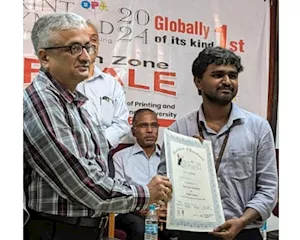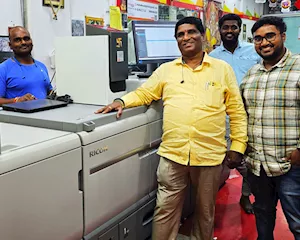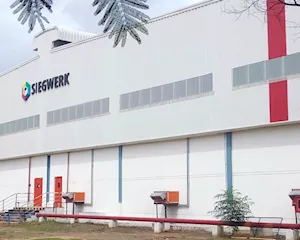AIFMP president Baruah: "The future of printing is fascinating and rapidly evolving"
At the 8th edition of the Print & Beyond conference organised by the Kerala Master Printers Association, Raghabendra N Dutta Baruah, the president of the All India Federation of Master Printers had a stirring message for the print and packaging industry.
07 Mar 2024 | By Ramu Ramanathan
AIFMP highlights
To begin with the All India Federation of Master Printers (AIFMP). Established in 1953, the AIFMP is the sole representative of 250,000 printing companies of India, the world’s largest printers’ association, drawing its strength from over 80 regional associations spread across the country. For the purpose of strengthening the printing industry, AIFMP supports, participates in and organises a number of regional, national and international events with the aim of lobbying for the interests of the Indian printers, showcasing the Indian printing industry’s achievements and holding technical seminars and exhibitions for educating the printers about global trends and technologies.
The exposition of printing and graphic machinery and technology, Pamex is organised by AIFMP. Pamex 2024 concluded from 6 to 9 February at the Bombay Exhibition Centre, Mumbai. With over 30,000 unique visitors, over 450 exhibitors and 200+ running machines, it is the most valuable expo of the world of printing in India. The next edition will be in January 2026.
In addition, AIFMP maintains two indexes for the printing industry, PRIDEX for commercial print and CARDEX for packaging in association with the world-renowned rating agency CRISIL. These are the only indexes for printing in the world. These indexes track the changes in printing cost taking into consideration all relevant parameters like paper, consumables, wages etc. which will help you calculate your cost and also negotiate with customers.
Also AIFMP organises a series of technical seminars under the name Romancing Print in tier 2 and tier 3 cities plus towns across four regions of the country, which are led by the regional vice presidents. This is aimed at reaching out to grassroots level printers to enable them to know and learn of new developments and trends and tackle technical issues related to printing.
The National Awards for Excellence in Printing is also organised by AIFMP, supported by the Government of India, the 16th edition was presented concurrently with Pamex 2024 at Mumbai on 8 February along with the 2nd Global Print Excellence Awards, which allows Indian printers to compete with international players.
Technological advancements
Now coming to our subject of discussion, as we stand on the cusp of a new era, technological advancements are reshaping the way we think about and interact with print media. Let's start by acknowledging the roots of printing. From the Gutenberg press to the 3D printer, humanity has always sought ways to reproduce and share information. Today, we find ourselves at a pivotal moment where the convergence of digital technologies is driving the next wave of printing evolution.
In the words of Wendell Phillips, American abolitionist and lawyer, "What gunpowder did for war the printing press has done for the mind." For this seminal development, we have to thank Johannes Gutenberg, whom we commemorate today as Printers Day.
One of the most significant trends shaping the future of printing is 3D printing, also known as additive manufacturing. This groundbreaking technology has already revolutionised industries such as healthcare, aerospace, and automotive. The ability to create three-dimensional objects layer by layer is changing the way we manufacture goods, making it more efficient, cost-effective, and customisable. In the future, we can expect 3D printing to extend its reach, impacting everything from fashion to architecture.
Moreover, the integration of artificial intelligence (AI) with printing processes is opening up new possibilities. AI algorithms can optimise printing workflows, enhance image quality, and even predict potential issues before they occur. Smart machines equipped with AI capabilities can learn from past printing jobs, leading to continuous improvement in efficiency and resource utilisation.
All about sustainability
On the environmental front, sustainable printing practices are becoming increasingly important. As we confront the challenges of climate change, the printing industry is adapting by embracing eco-friendly materials and energy-efficient technologies. The future of printing will undoubtedly see a rise in environmentally conscious solutions, reducing the ecological footprint of the industry.
There is a fallacious message being propagated that paper is bad. The electricity that is used to power electronic devices is still predominantly from thermal sources like coal and oil and the heavy and rare metals that go into making electronic circuits are hugely polluting to mine and to recycle. So, reading an email and not printing it is not always green. Today, most paper is sourced from renewable captive forests and from recycled sources.
The paper industry in India produces 5% of the world’s total paper, with a domestic market size of Rs. 80,000 crore. This is despite the fact that the industry is highly fragmented, comprising many small, medium, and large paper mills with paper production capacity ranging from 10 to 1650 tonnes per day. The domestic output increased during April 2022-January 2023 by 6.7 per cent. The production reached 55,53,900 tonnes in the ten months ending January 2023.
Innovative startups like Zerocircle are working on paper, transparent film and barrier coatings derived from seaweed grown offshore in Maharashtra in a region where there aren’t enough fish left to sustain local fishermen, working with a resource that is ubiquitous and needs no freshwater to produce and providing the communities with an alternative income source. Craste is working with farmers in UP and the North India Rice belt to utilise the discarded stubble after harvest for paper and disposable crockery. This stubble is infamous for being burnt and then contributing to the smog that disrupts most of North India in winters. This has
helped farmers increase yields by 40 percent per acre, giving them a reason to not use a matchstick to clear their fields, the most cost-efficient means otherwise.
Strides in digital print
The rise of digital printing has already transformed the landscape of traditional publishing. EBooks, online articles, and digital media have become ubiquitous, challenging the dominance of physical books and newspapers. However, the future of printing is not about the demise of traditional forms but rather the synergy between digital and print media. Augmented reality (AR) and virtual reality (VR) technologies are being integrated into print materials, providing immersive and interactive experiences for readers.
Additionally, the Internet of Things (IoT) is playing a pivotal role in the evolution of printing. Connected machines can communicate with other devices and platforms, facilitating seamless printing experiences. Imagine a scenario where your printing machine communicates with a smart network system to reorder ink or plates when supplies are low. The integration of IoT will make printing more intuitive, efficient, and user-friendly.
As we look ahead, challenges and ethical considerations must not be overlooked. Privacy concerns related to the data generated by smart machines, environmental impacts of increased production, and the need for cybersecurity in a connected printing ecosystem are all areas that demand careful attention and responsible innovation.
Today printing is growing at around 4% CAGR globally, so by no means is it dead. In conclusion, the future of printing is a dynamic and exciting landscape. From 3D printing revolutionising manufacturing to AI optimising workflows, sustainable practices, and the integration of digital technologies, the possibilities are vast. The key lies in embracing these advancements responsibly, ensuring that the future of printing is not only technologically advanced but also sustainable, inclusive, and ethically sound.
I look forward to witnessing the insights from the industry stalwarts present at the Print & Beyond seminar and listen to the incredible transformations that lie ahead in the world of printing.














 See All
See All